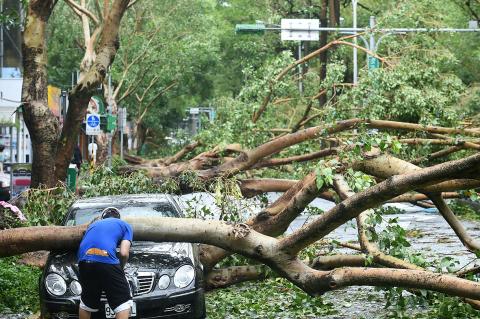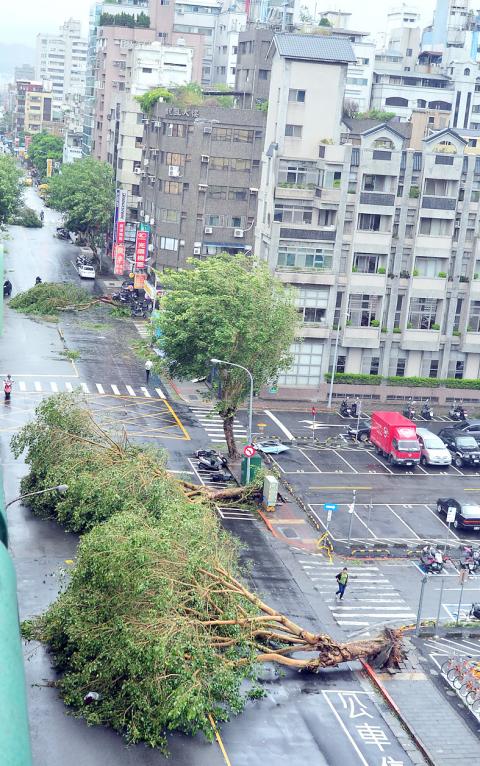Horticulturalists yesterday commented on the multitude of road trees brought down by the passage of Typhoon Soudelor, reportedly numbering 6,182 nationwide, saying that authorities should abandon erroneous horticultural practices currently in use to prevent trees from being destroyed.
The sheer number of trees toppled by the typhoon drew the attention of environmental activists, including veteran environmentalist Lin Chang-mao (林長茂) and National Chung Hsing University professor of horticulture Liu Tung-chi (劉東啟), who expounded on what they said were problems facing trees overseen by government agencies.
Lin, a self-taught horticulturalist, criticized the methods employed by most public-sector horticulturalists, saying there is much to consider when planting trees rather than simply “plunging a plant into the ground.”

Photo: Chien Jung-fong, Taipei Times
He attributed the large number of wind-toppled trees to inappropriate trimming of twigs and an overreliance on frames used to prop up trees.
He said that twigs form V-shaped or L-shaped tree forks from the main trunk shortly after they sprout, and that V-shaped forks should be removed, as they are more prone to “included bark junctions,” which make long rifts in the trunk, undermining a tree’s sturdiness.
He said that twigs in V-shaped tree forks should be removed at an early stage, when the twigs are less than 3cm long, otherwise the resulting damage will be impossible to heal.

Photo: Wang Yi-sung, Taipei Times
“Since the two limbs of a V-shaped tree fork sway in different directions, which widens the separation, removing twigs measuring more than 3cm in length would result in cuts that are impossible to heal completely,” he said.
“Consequently, bacteria and fungi can gain a foothold in joints between the limbs and the trunk, and from there slowly hollow out the tree. Eventually, the tree will collapse,” he said.
Lin said government agencies overseeing plants often use props to stabilize trees over an excessive amount of time, which hampers the growth of roots, as the practice makes it difficult for trees to adapt to wind.
“Once the props are removed, the trees, having underdeveloped roots, can easily collapse,” he said, adding that all shores should be removed within three years so that an evaluation can be performed on whether a tree has developed roots strong enough to withstand strong winds.
Meanwhile, Liu said that while many of the horticultural practices in use by government agencies are wrong, he would not assign blame.
Liu, a member of the Taiwan Greening Technology Association, said he instead plans to launch a campaign calling on members of the public to take photographs of felled trees and send them to the association for analysis.
“From the pictures, we will be able to tell whether the trees collapsed due to improper trimming or if they were felled by strong winds,” he said.
This approach would enable him and other tree protection workers to get to the bottom of problems by “learning from” trees, both standing and felled.
He said that tree surgery, which was banned by the American National Standards Institute in 1990, is still widely performed in collaborations between the public and private sectors, and that his organization would launch workshops to disseminate correct tree protection knowledge.

The brilliant blue waters, thick foliage and bucolic atmosphere on this seemingly idyllic archipelago deep in the Pacific Ocean belie the key role it now plays in a titanic geopolitical struggle. Palau is again on the front line as China, and the US and its allies prepare their forces in an intensifying contest for control over the Asia-Pacific region. The democratic nation of just 17,000 people hosts US-controlled airstrips and soon-to-be-completed radar installations that the US military describes as “critical” to monitoring vast swathes of water and airspace. It is also a key piece of the second island chain, a string of

A magnitude 5.9 earthquake that struck about 33km off the coast of Hualien City was the "main shock" in a series of quakes in the area, with aftershocks expected over the next three days, the Central Weather Administration (CWA) said yesterday. Prior to the magnitude 5.9 quake shaking most of Taiwan at 6:53pm yesterday, six other earthquakes stronger than a magnitude of 4, starting with a magnitude 5.5 quake at 6:09pm, occurred in the area. CWA Seismological Center Director Wu Chien-fu (吳健富) confirmed that the quakes were all part of the same series and that the magnitude 5.5 temblor was

Taiwan will now have four additional national holidays after the Legislative Yuan passed an amendment today, which also made Labor Day a national holiday for all sectors. The Chinese Nationalist Party (KMT) and Taiwan People’s Party (TPP) used their majority in the Legislative Yuan to pass the amendment to the Act on Implementing Memorial Days and State Holidays (紀念日及節日實施辦法), which the parties jointly proposed, in its third and final reading today. The legislature passed the bill to amend the act, which is currently enforced administratively, raising it to the legal level. The new legislation recognizes Confucius’ birthday on Sept. 28, the

The Central Weather Administration has issued a heat alert for southeastern Taiwan, warning of temperatures as high as 36°C today, while alerting some coastal areas of strong winds later in the day. Kaohsiung’s Neimen District (內門) and Pingtung County’s Neipu Township (內埔) are under an orange heat alert, which warns of temperatures as high as 36°C for three consecutive days, the CWA said, citing southwest winds. The heat would also extend to Tainan’s Nansi (楠西) and Yujing (玉井) districts, as well as Pingtung’s Gaoshu (高樹), Yanpu (鹽埔) and Majia (瑪家) townships, it said, forecasting highs of up to 36°C in those areas